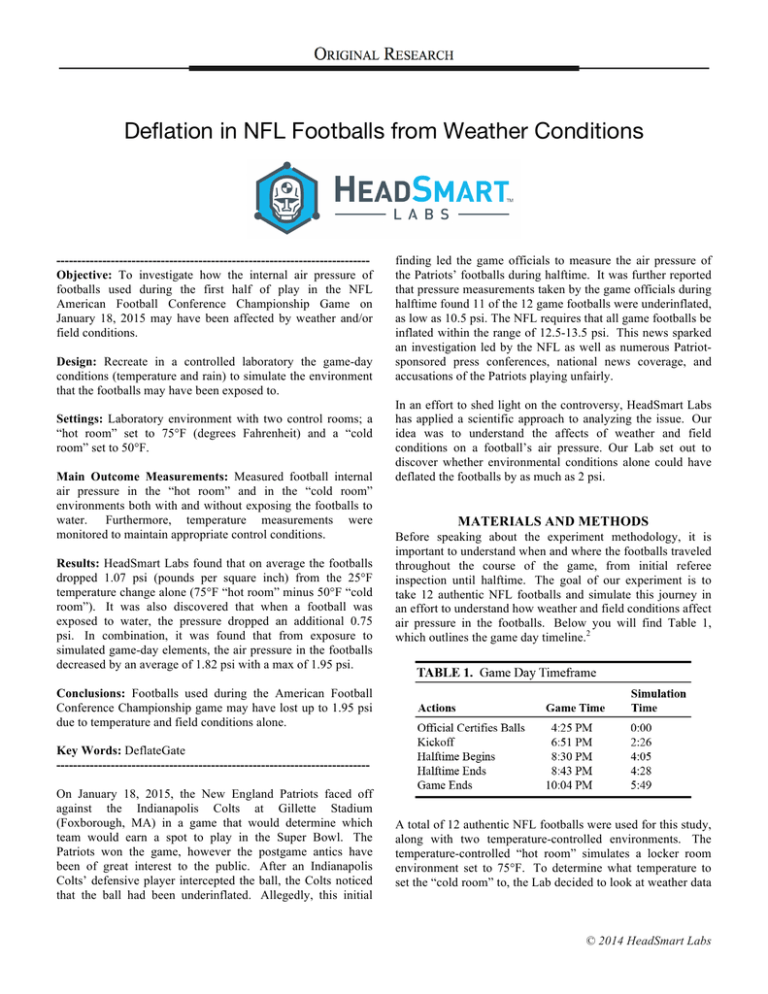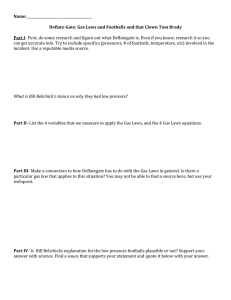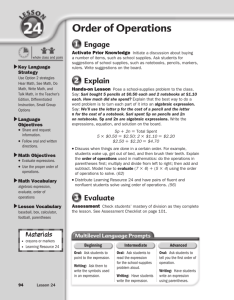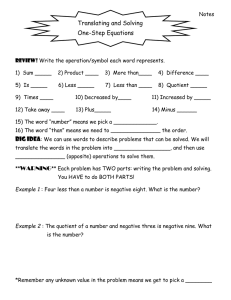
Deflation in NFL Footballs from Weather Conditions
--------------------------------------------------------------------------Objective: To investigate how the internal air pressure of
footballs used during the first half of play in the NFL
American Football Conference Championship Game on
January 18, 2015 may have been affected by weather and/or
field conditions.
Design: Recreate in a controlled laboratory the game-day
conditions (temperature and rain) to simulate the environment
that the footballs may have been exposed to.
Settings: Laboratory environment with two control rooms; a
“hot room” set to 75°F (degrees Fahrenheit) and a “cold
room” set to 50°F.
Main Outcome Measurements: Measured football internal
air pressure in the “hot room” and in the “cold room”
environments both with and without exposing the footballs to
water. Furthermore, temperature measurements were
monitored to maintain appropriate control conditions.
Results: HeadSmart Labs found that on average the footballs
dropped 1.07 psi (pounds per square inch) from the 25°F
temperature change alone (75°F “hot room” minus 50°F “cold
room”). It was also discovered that when a football was
exposed to water, the pressure dropped an additional 0.75
psi. In combination, it was found that from exposure to
simulated game-day elements, the air pressure in the footballs
decreased by an average of 1.82 psi with a max of 1.95 psi.
finding led the game officials to measure the air pressure of
the Patriots’ footballs during halftime. It was further reported
that pressure measurements taken by the game officials during
halftime found 11 of the 12 game footballs were underinflated,
as low as 10.5 psi. The NFL requires that all game footballs be
inflated within the range of 12.5-13.5 psi. This news sparked
an investigation led by the NFL as well as numerous Patriotsponsored press conferences, national news coverage, and
accusations of the Patriots playing unfairly.
In an effort to shed light on the controversy, HeadSmart Labs
has applied a scientific approach to analyzing the issue. Our
idea was to understand the affects of weather and field
conditions on a football’s air pressure. Our Lab set out to
discover whether environmental conditions alone could have
deflated the footballs by as much as 2 psi.
MATERIALS AND METHODS
Before speaking about the experiment methodology, it is
important to understand when and where the footballs traveled
throughout the course of the game, from initial referee
inspection until halftime. The goal of our experiment is to
take 12 authentic NFL footballs and simulate this journey in
an effort to understand how weather and field conditions affect
air pressure in the footballs. Below you will find Table 1,
which outlines the game day timeline.2
Conclusions: Footballs used during the American Football
Conference Championship game may have lost up to 1.95 psi
due to temperature and field conditions alone.
Key Words: DeflateGate
--------------------------------------------------------------------------On January 18, 2015, the New England Patriots faced off
against the Indianapolis Colts at Gillette Stadium
(Foxborough, MA) in a game that would determine which
team would earn a spot to play in the Super Bowl. The
Patriots won the game, however the postgame antics have
been of great interest to the public. After an Indianapolis
Colts’ defensive player intercepted the ball, the Colts noticed
that the ball had been underinflated. Allegedly, this initial
A total of 12 authentic NFL footballs were used for this study,
along with two temperature-controlled environments. The
temperature-controlled “hot room” simulates a locker room
environment set to 75°F. To determine what temperature to
set the “cold room” to, the Lab decided to look at weather data
© 2014 HeadSmart Labs
January 2015
from the two closest weather stations to Gillette Stadium,
Norwood, MA and Pawtucket, RI. Norwood is located 7.8
miles north-north-east of Gillette Stadium, while Pawtucket is
13.3 miles south-south-west of the stadium.1 In Table 2, you
can see the different temperatures at their respective times
throughout the game.3
them with a damp towel until the footballs were thoroughly
saturated. Measurements of football inflation pressure were
taken every 30 minutes after saturation. From Table 1 we
know that halftime takes place in between our 90 minute and
120 minute after kickoff pressure readings. The readings from
these two times gave us an estimation as to what impact
environmental conditions could have had on the game
footballs.
For our testing, we used a calibrated Molten PGP Deluxe
Digital Air Gauge with a needle moistened by glycerine.
While testing, the footballs were placed on a metal wire shelf
to allow airflow over them. In addition, there were fans
circulating air around the footballs to simulate the windy game
conditions.
RESULTS
After letting the footballs cool in the “cold room” for 2 hours
and 26 minutes (to simulate the time period between when the
referees inspected the footballs and kickoff), the Lab found
that the 12 footballs had experienced a drop in pressure. See
Table 4.
Since there is no weather data from Gillette Stadium, the Lab
averaged weather data from these two cities, and concluded
that the “cold room” environment should be 50°F. These
weather estimations can be found below in Table 3.
From the table above, it can be seen that the average pressure
drop of the 12 footballs was 1.07 psi (12.50 psi minus 11.43
psi) below the starting pressure.
The next step in the experiment was to mimic the effects of
the wet field conditions. In Table 5, we can see the different
pressures in the footballs from both 90 minutes and 120
minutes after the footballs were saturated in water.
We began our study by having all 12 footballs in the “hot
room” where they were inflated to 12.5 psi. This simulated
when the referees would have inspected the footballs before
the game in their locker room. This process usually takes
place 2 hours and 15 minutes before game time but since the
game was delayed there was an additional 11 minutes before
kickoff. Once the footballs were inflated, they were then
moved to the “cold room” to simulate the footballs being
moved outdoors and onto the field.
In Table 4 and Table 5, it can be seen that there was an
additional average pressure drop within the footballs of 0.75
psi (11.43 psi minus 10.68 psi).
Once 2 hours and 26 minutes passed, we measured the
pressure in all the footballs. This demonstrated how much
pressure was lost due to temperature changes. After taking
our first readings, we dampened the footballs to simulate the
rainy weather during the game. This was done by manually
rotating each of the footballs in 50°F water baths and blotting
2
© 2014 HeadSmart Labs
January 2015
calculate the percent volume change that the football will
experience.4 The equation is outlined below:
P1 = 11.43 psi gauge (26.13 psi absolute)
P2 = 10.68 psi gauge (25.38 psi absolute)
DISCUSSION
As articulated in the results section of this paper, the footballs
experienced a 1.07 psi average pressure drop due to changes in
temperature. This can be explained using a simplified version
of the Ideal Gas Law, Gay-Lussac’s Law.4 The law assumes a
fixed mass of gas at constant volume:
(P1)* (V 1) = (P 2 )* (V 2 )
P1 P 2
=
T1 T 2
This relationship between temperature and pressure is direct;
as temperature decreases, pressure decreases. To check the
experimental results, the equation can be used to determine
what the initial temperature would need to be in order to see
this pressure change. The equation is outlined below:
P1 = 12.50 psi gauge (27.20 psi absolute)
P2 = 11.43 psi gauge (26.13 psi absolute)
T2 = 50°F (509.7° Rankine)
V 2 P1 26.13psi
=
=
= 1.030
V 1 P 2 25.38psi
From this we can conclude that the volume of the football
would have expanded by 3.0% in order to account for this
pressure decrease.
With these variables, we can determine T1:
SUMMARY
! P1 $
# & *T 2 = T 1
" P2 %
These findings support the fact that due to the rainy conditions
and a 25°F decrease in the footballs’ temperatures, it is
expected that the footballs would experience a pressure
decrease of about 1.82 psi.
! 27.20 psi $
#
& * 509.7R = 530.6R = 70.93°F
" 26.13psi %
REFERENCES
1.
These results are relatively similar to what we would have
expected to see since our initial “hot room” temperature was at
75°F.
2.
3.
Next we will look at the pressure loss due to the affects of
water. When materials such as leather get wet, they absorb
water and tend to expand. When the leather and the woven
fabric lining of the football became wet, we can conclude that
the volume of the football increased which reduced the
pressure in the footballs. We can use Boyle’s Law in order to
4.
3
"Free Map Tools." Measure Distance on a Map. N.p., n.d.
Web. 29 Jan. 2015.
"Historical Weather." Weather Underground. N.p., n.d.
Web. 29 Jan. 2015.
"Indianapolis Colts 7-45 New England Patriots: AFC
Championship Game – as It Happened." The Guardian.
N.p., 18 Jan. 2015. Web.
Young, Hugh D., Roger A. Freedman, A. Lewis Ford, and
Francis Weston Sears. "Thermal Properties of Matter."
Sears and Zemansky's University Physics: With Modern
Physics. San Francisco: Pearson Addison Wesley, 2008.
610-17. Print.
© 2014 HeadSmart Labs





